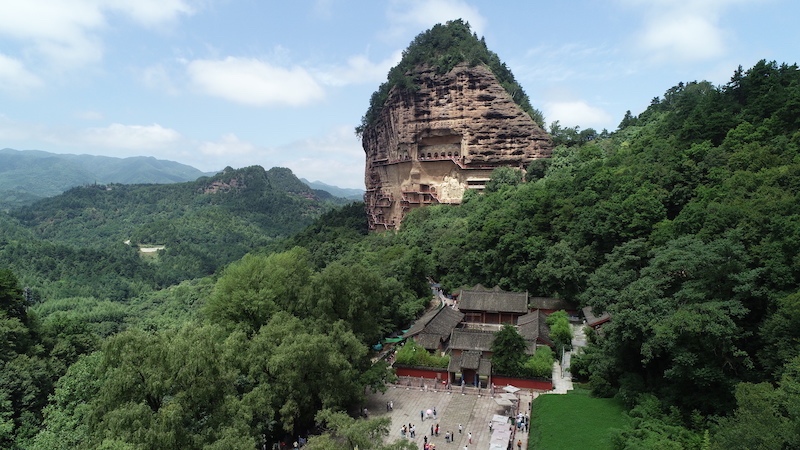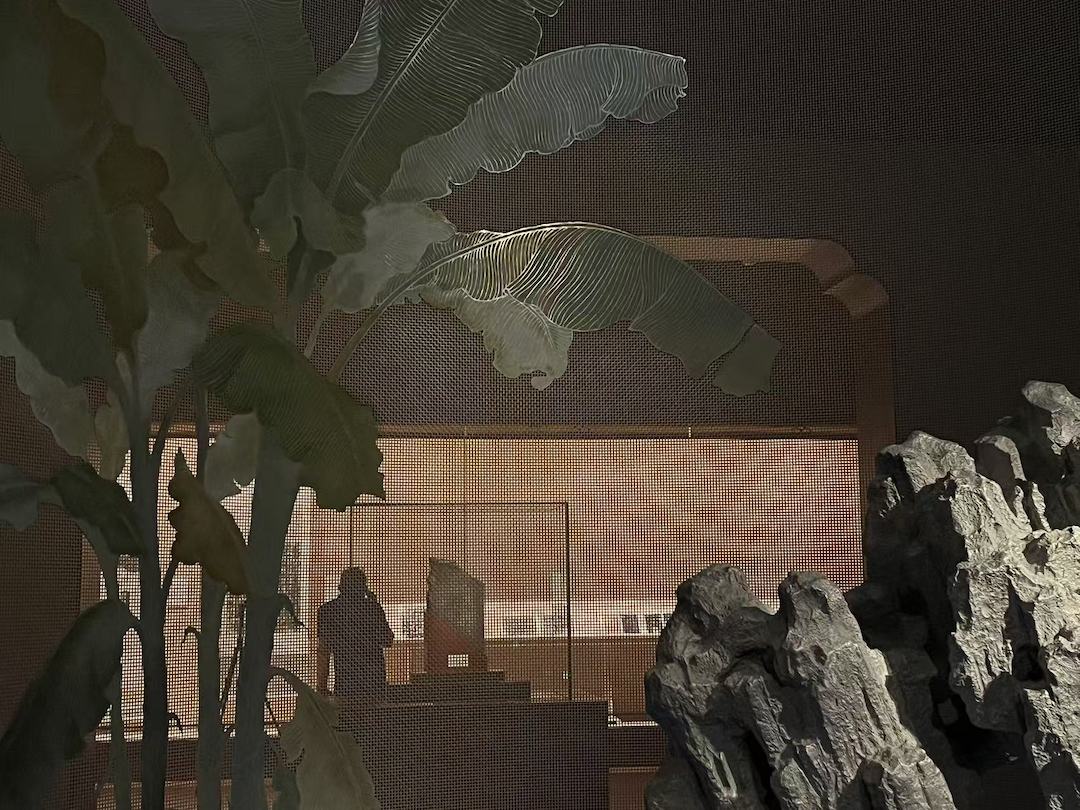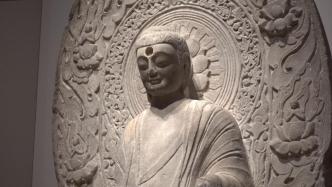
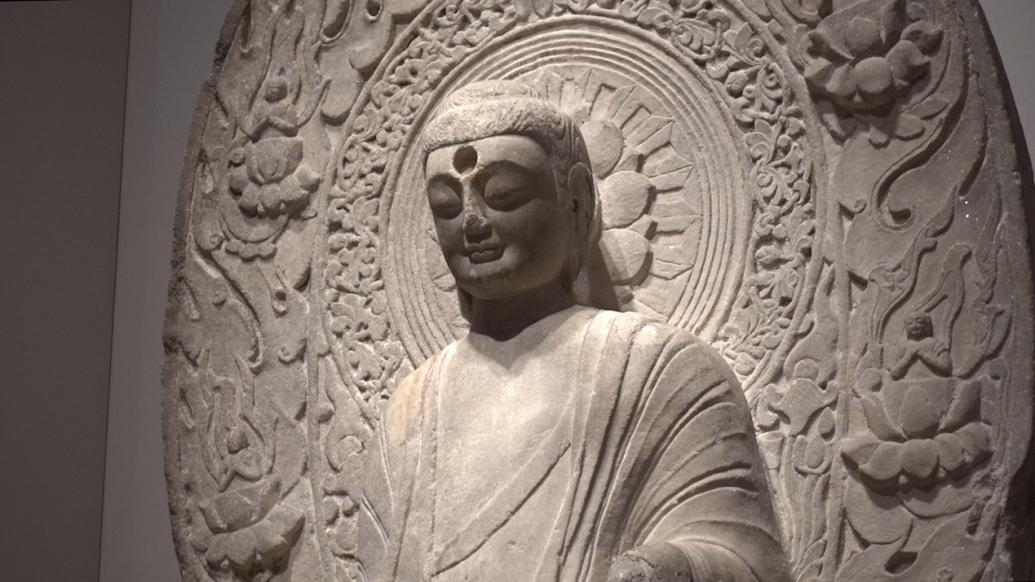
Starting from March 16, the Ancient Chinese Sculpture Hall (hereinafter referred to as the Sculpture Hall), the second permanent exhibition hall in the East Building of the Shanghai Museum, will be open to the public on a trial basis after a comprehensive upgrade, innovation and renovation.
The Paper has learned that the fully upgraded Sculpture Hall has expanded the categories of cultural relics on display and extended the history of the exhibition line. The entire exhibition displays a total of 289 pieces/sets of three-dimensional cultural relics, nearly twice the number compared to the People's Square Pavilion Sculpture Exhibition, of which one-third are on public display for the first time. Among them are many representative treasures and orphan cultural relics, such as the largest gilt-bronze Buddha statue of the Dali Kingdom in the world, and the only standard Yuan Dadu statue with the inscription "Dadu" unearthed by archeology, the Qingtian Stone "Dadu Buddha Zhang Made" "Buddha statues" are all unique items. The display also displays for the first time a batch of Yungang Grottoes statue fragments that were recovered from Japan in the late 1940s; a comparative display of Buddhist statues from the Northern and Southern Dynasties is highlighted in the center of the exhibition hall.
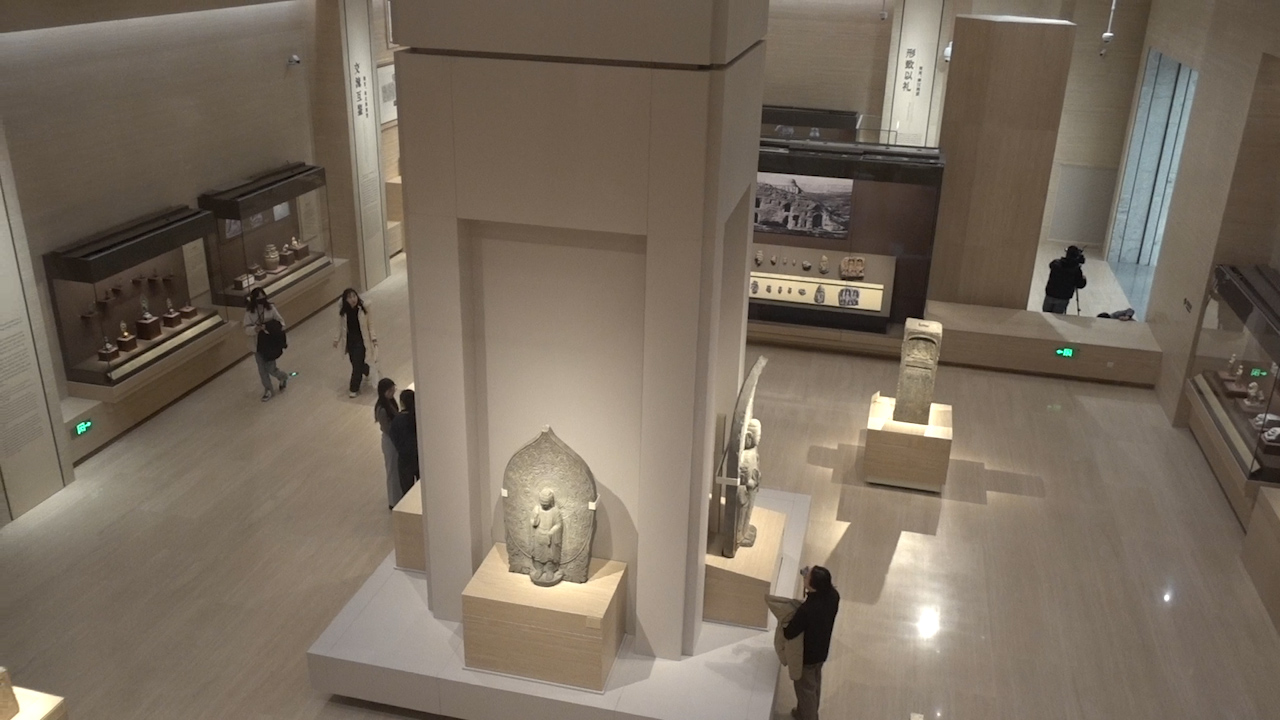
exhibition site
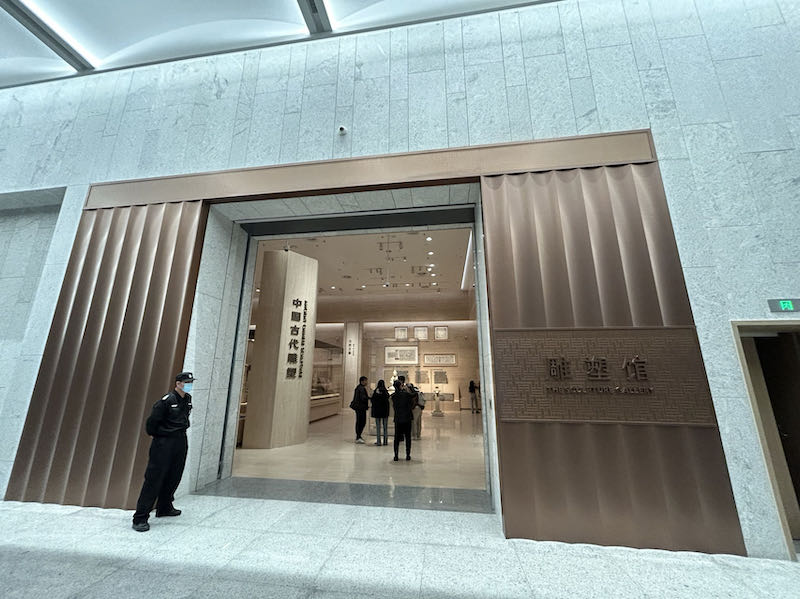
Shanghai Museum East Building Sculpture Hall
A general history display that runs through ancient Chinese sculpture art
According to the Shanghai Museum, the exhibition in the Sculpture Hall of the East Hall of the Shanghai Museum is based on the renovation and upgrading of the Sculpture Hall of the People's Square Hall, which is mainly reflected in the expansion of cultural relic categories and the historical extension of the exhibition line. In terms of the expansion of cultural relic categories, the exhibition is based on the three-dimensional cultural relics in the collection. From an artistic perspective, it displays and explains the bone carvings, jade carvings, bronzes, wooden figurines, pottery figurines, tomb carvings, gold and bronze statues, stone statues, and wood carvings in the Shanghai Museum. Statues, clay statues, porcelain sculptures, bamboo, wood, ivory carvings, etc., enrich the categories of sculptures and cultural relics on display. In terms of the historical extension of the exhibition line, based on the four major sections of the original sculpture museum: "Warring States, Qin and Han Dynasties", "Wei, Jin, Southern and Northern Dynasties", "Sui, Tang and Five Dynasties", and "Song, Liao and Jin", the exhibition expanded forward to the Shang and Zhou dynasties, enriching the Shang, Zhou and Qin and Han sections; The new section of the Yuan, Ming and Qing dynasties is added later to re-display the beauty of craftsmanship and the lively secular atmosphere of sculptures from this period that are close to modern people's aesthetics, changing the public's stereotyped image of the Yuan, Ming and Qing sculptures as being rigid, conservative and declining. On the basis of inheriting the original classic exhibition of the People's Square Sculpture Exhibition, it has been expanded and optimized to form five major sections: "Shang, Zhou, Qin and Han Dynasties", "Wei, Jin, Southern and Northern Dynasties", "Sui, Tang and Five Dynasties", "Song, Liao, Jin and Dali Kingdom" and "Yuan, Ming and Qing Dynasties". This is a tangible general history of ancient Chinese sculpture art.
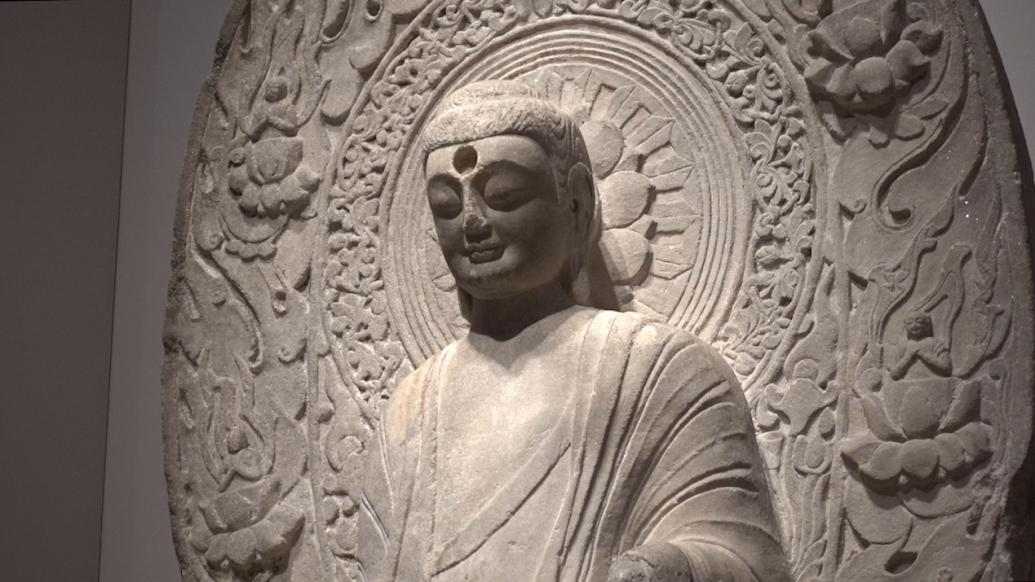
exhibition site
The exhibition uses time as the vertical axis to display representative works in the history of ancient Chinese sculpture. Such as bronze sculptures from the Pre-Qin Dynasty, pottery figurines and portrait stones from the Qin and Han Dynasties, plastic pots from the Wei and Jin Dynasties, gold, bronze and stone Buddhist statues from the Southern and Northern Dynasties, Sui and Tang Dynasties, relief statues from Yungang and Longmen Grottoes, pottery figurines from Qinling in the Southern Tang Dynasty during the Five Dynasties, Song, Liao and Jin Dynasties Temple statues, gold and bronze statues, the Tibetan, Han and palace statue systems of the Yuan, Ming and Qing dynasties, which were dominated by Tibetan Buddhist gold and bronze statues, as well as bamboo, wood, ivory carvings and other folk craft sculptures of the Ming and Qing dynasties are all covered.
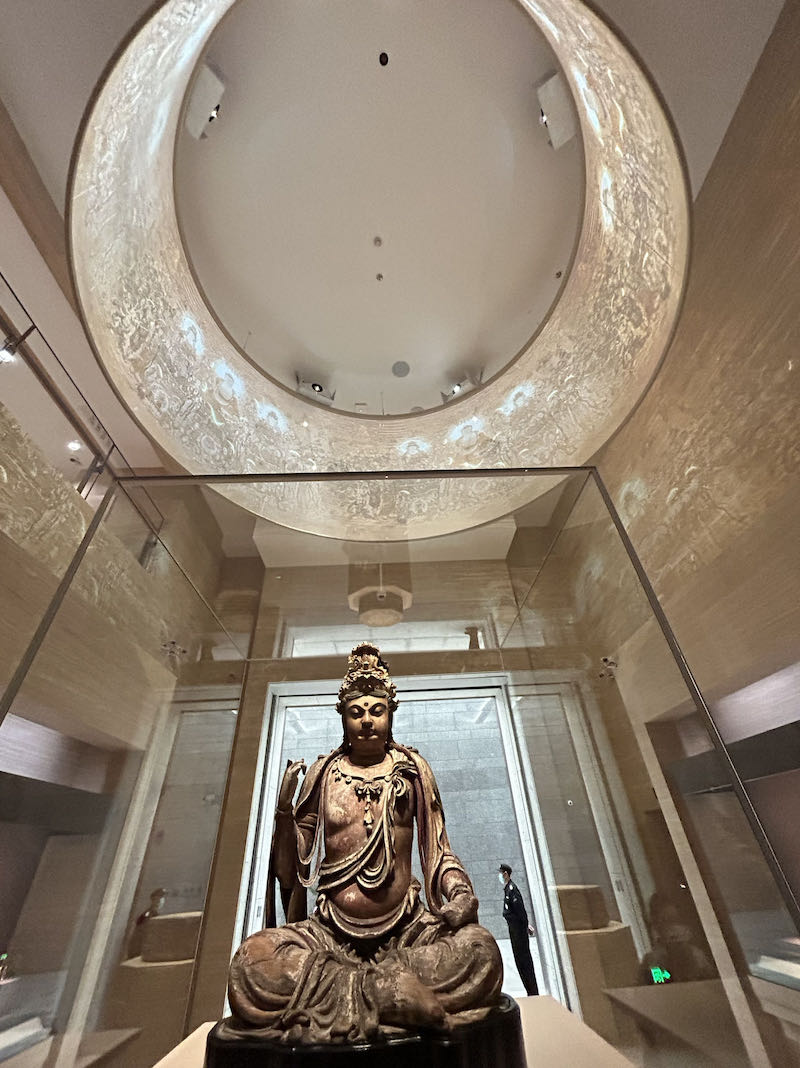
Gold lacquered and painted wood carving statue of Mahasthamaprapta Bodhisattva at the exhibition site
Chen Jie, deputy director of the Shanghai Museum, said that among museums at home and abroad, there are not many museums at home and abroad that can open such an exhibition that runs through the history of ancient Chinese sculpture art. The Shanghai Museum is based on its rich collections and the support of generations of Shanghai Museum visitors for more than 70 years. With continuous academic accumulation, we can create such an exhibition of the general history of ancient Chinese art.
The 8-meter-high space is brighter, brighter and more transparent
In addition to the expansion of content, after entering the exhibition hall, you will find that the display environment and atmosphere of the East Pavilion Sculpture Hall have changed significantly compared with the previous People's Square Pavilion. The exhibition hall of the People's Square Pavilion is relatively small, with compact exhibition lines and dark lighting. The audience can feel the solemn and tranquil feeling of Buddhist sculpture art in it. The new exhibition hall is more open and bright, with a height of nearly 8 meters, and richer spatial levels. It has an open space like a small square for displaying large-scale outdoor sculptures, as well as a mezzanine on the second floor and a viewing area on the mezzanine. The platform and the relatively independent large-scale multimedia immersive experience space give people a sense of transparency and pleasure.

Exhibition site Northern Qi White Stone Buddha Statue
Sculpture is a form of plastic art in a three-dimensional space, and a matching display space can better highlight the artistic beauty of the sculpture. According to Chen Jie, the fully upgraded sculpture hall has made new attempts in both content and form. "This upgraded display format is more in line with the current trend of sculpture display in some large international museums, so we are also making such an attempt."

exhibition site
In addition to cabinet exhibitions, a large number of sculptures are also displayed in the form of naked exhibitions. According to experts, cabinet exhibitions are suitable for displaying precious cultural relics with more "delicate" materials. For some stone sculpture cultural relics, the naked exhibition method is also in line with the common method of international museums. At the same time, it also continues the tradition of the previous People's Square Pavilion, allowing the audience to view the cultural relics more closely and without obstacles. Of course, the museum will also set up some "no touching" signs to remind visitors to view the exhibition in a civilized manner.
1/3 of the cultural relics are on display for the first time, and there are many treasures and orphans.
The Sculpture Hall of the East Pavilion of Shanghai Bodhisattva exhibits nearly 300 precious cultural relics, which is nearly twice the number of the Sculpture Exhibition of the People's Square Pavilion. One-third of them are on public display for the first time, including many representative treasures and orphans. Cultural relics, such as the Dali gilt-bronze Buddha statue with the sun shining all over it, is the largest gilt-bronze Buddha statue in Dali with the sun shining all over it; there is also a Qingtian stone Buddha statue made by Dadu Buddha, which is the only one with the word "大都" unearthed by archeology. The standard Yuan Dadu statues with inscriptions are all unique. At the same time, in order to enrich the exhibition system, Shanghai Expo has borrowed some rare cultural relics that are very important in the history of sculpture from brother institutions in the cultural and museum circles, such as the remains of Southern Dynasty stone statues unearthed from the Wanfo Temple site in Chengdu collected by the Sichuan Museum.
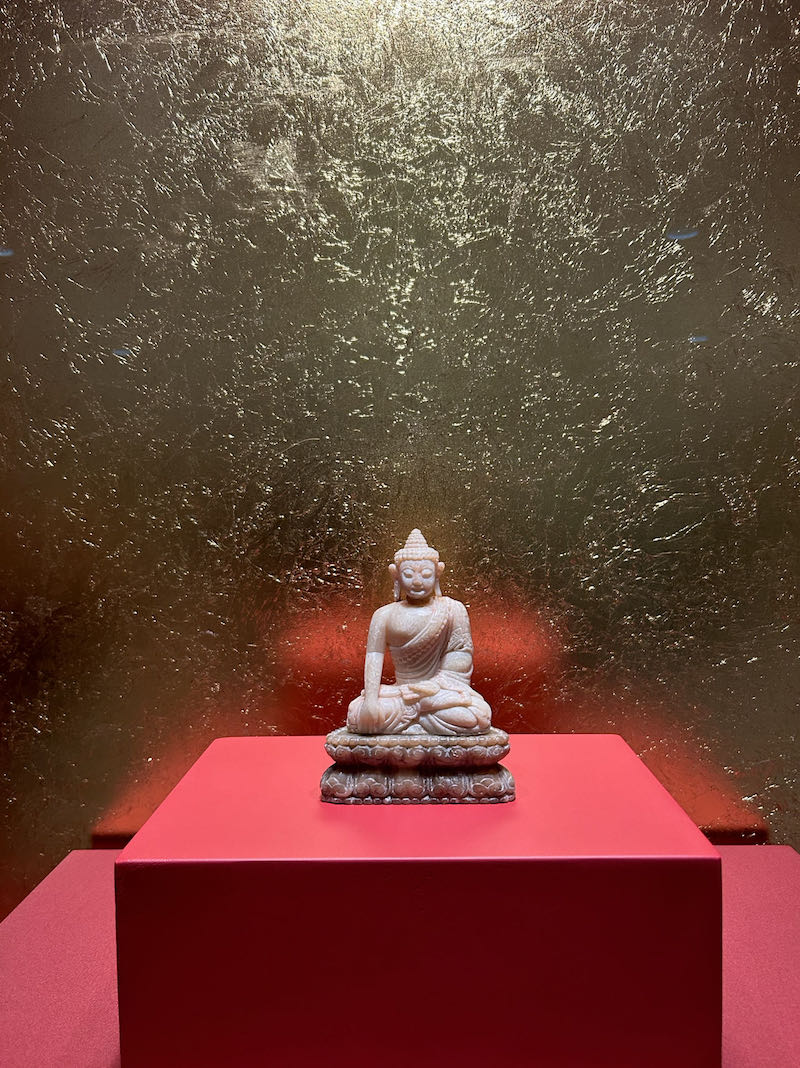
Exhibition scene Qingtian stone Buddha statue made by Dadu Buddha Zhang Yuan Dynasty (1271-1368 AD)
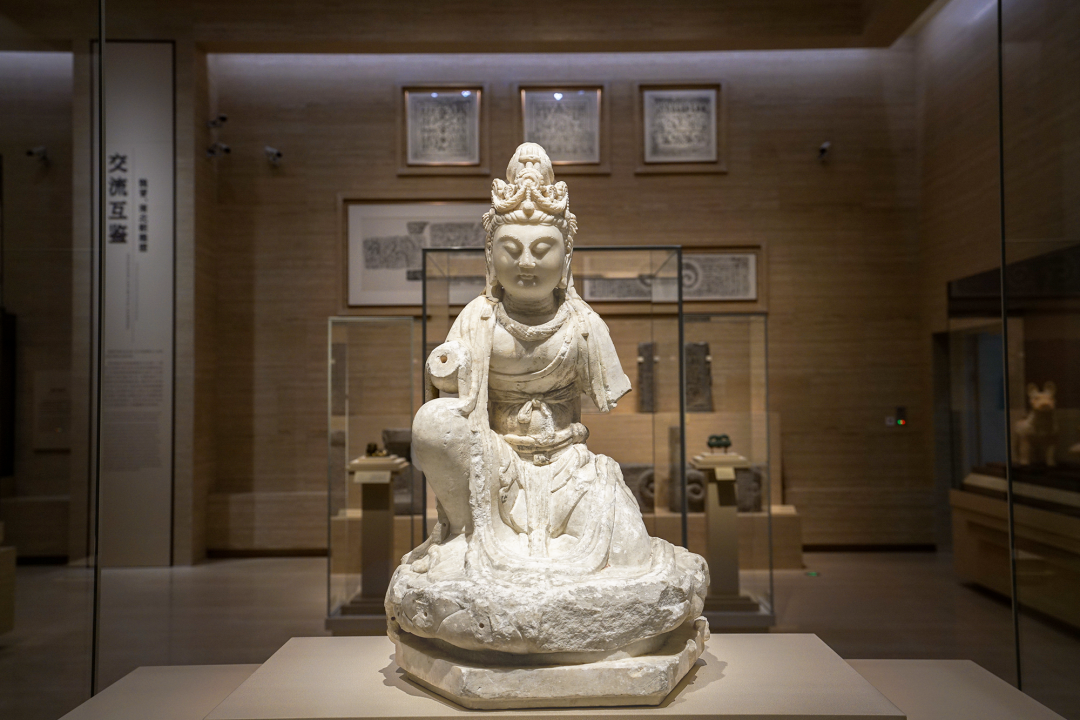
Exhibition site: Tang Baishi offering offerings to the Bodhisattva statue
When entering the exhibition hall, the first thing that catches the eye is the Tang Baishi Bodhisattva statue displayed in the "C position" at the entrance of the exhibition hall. This statue of the Bodhisattva is all white, with hair in a high bun, a crown, and ribbons hanging from both shoulders. The face is round, the eyebrows are curved, the eyes are half-open and looking downward, the bridge of the nose is straight, and the lips are slightly pursed with a smile, making him appear quiet and peaceful. The Bodhisattva is missing both forearms and hands, and is squatting on the lotus platform with his bare feet.
According to experts, this Bodhisattva statue is made of white marble. In ancient white marble (referred to as white stone) statues and vows, this type of stone statue is often called "jade statue". Especially during the reign of Emperor Xuanzong of the Tang Dynasty, white stone statues in Chang'an reached their peak. This white stone offering Bodhisattva statue originated from Chang'an during the Xuanzong period. In terms of material and craftsmanship, it is closely related to the white stone statues in the area east of the Taihang Mountains. It is an excellent work of white stone statues in the prosperous Tang Dynasty.
The pure white appearance of this Bodhisattva statue in the Shanghai Museum is particularly eye-catching in the exhibition hall. There are still traces of painting on its chest, abdomen and long skirt. You can imagine how gorgeous this Bodhisattva statue was back then.
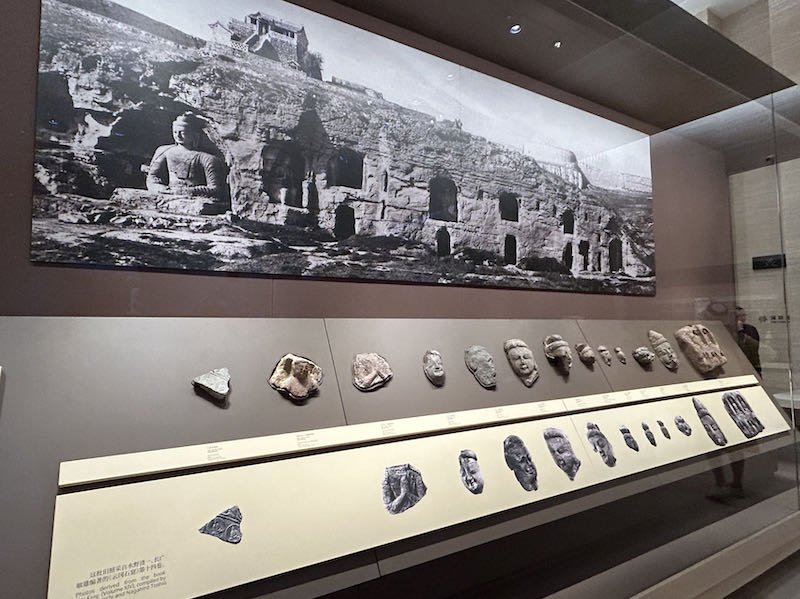
Fragments of Yungang Grottoes statues at the exhibition site
The upgraded Sculpture Hall also displays for the first time a batch of Yungang Grottoes statue fragments that were recovered from Japan in the late 1940s. According to Shi Ruoyu, associate research librarian of the Bronze Research Department of the Shanghai Museum, these fragments of statues from the Yungang Grottoes were originally "lying" in the Shangbo warehouse in obscurity. In 2000, they accidentally discovered them while sorting out the cultural relics in the warehouse. After sorting and researching, they found that they were actually recorded cultural relics that they had read in the book "Yungang Grottoes" compiled by Japanese scholars Mizuno Seiichi and Nagahiro Toshio when they were students. .
Shi Ruoyu introduced that this batch of sixteen Yungang Grottoes statues were from 1939 to 1940. Mizuno Seiichi, Nagahiro Toshio and others from the Japanese Institute of Oriental Culture formed a Yungang investigation team to clean up the "Tanyao Five Grottoes" (No. 16 to 20) and were transported back to Japan and stored at the Institute of Oriental Culture in Kyoto before the end of the Anti-Japanese War. After the victory of the Anti-Japanese War, thanks to the efforts of Li Ji, Zhang Fengju and others, these statues were recovered and returned to China in 1948. After the founding of New China, in compliance with the instructions of the Central Government Affairs Council and the Shanghai Municipal People's Government, these cultural relics were collected in the Shanghai Museum in 1955.
"Because it has been so long, the whereabouts of this batch of cultural relics have not been very clear before. The sorting out in 2000 can be regarded as a clear understanding of the ins and outs of these statues." Shi Ruoyu said that judging from the artistic style of the sculptures, these grottoes The remains of the statues change from early to late according to the time when the grottoes were opened. It can be seen that the statues in the early Yungang Grottoes are more Western style. For example, the faces of the characters are rounder, the facial features are more concentrated, and the characters are relatively strong and burly. Change to China's Wei and Jin style and elegant style.
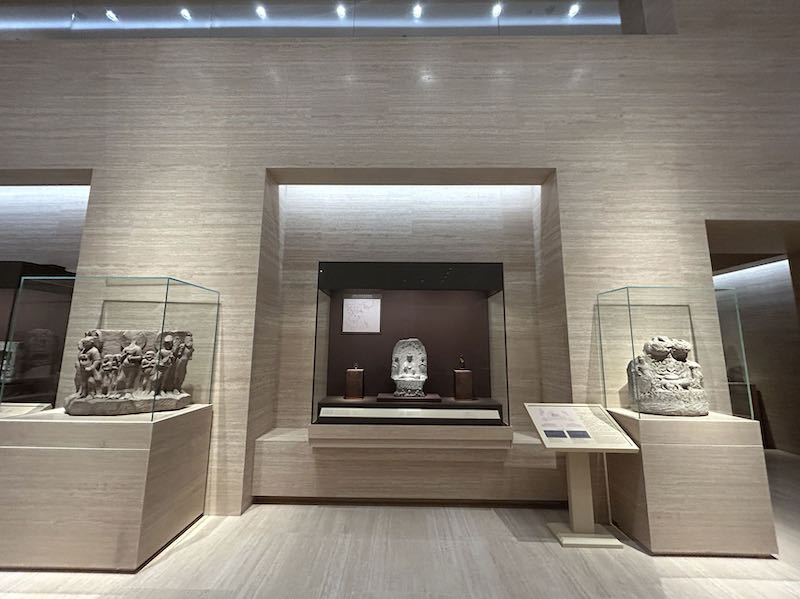
exhibition site
In addition, the upgraded sculpture hall highlights the contrasting display of Buddhist statues from the Northern and Southern Dynasties in the open space in the center of the exhibition hall. According to Shi Ruoyu, the Southern and Northern Dynasties were the first period of prosperity for Chinese Buddhist sculpture art. The statues of the Northern Dynasties were influenced by Central Asia and the Western Regions, making them stronger and more vigorous; the statues of the Southern Dynasties were more delicate. This exhibition will "confront" the sculptures of the Southern and Northern Dynasties, allowing the audience to better understand the differences in the sculpture art styles of the Southern and Northern Dynasties. However, due to the scarcity of Southern Dynasty statues in existence, there are only a handful of Southern Dynasty statues collected by Shanghai Bo. Therefore, Shanghai Bo has specially loaned two Southern Dynasty sculptures to the Sichuan Museum for a two-year exhibition period. One of them is the "Remnant Stele of Southern Dynasty Stone Statues Unearthed from the Wanfo Temple Site in Chengdu". The fusion of Hu and Han music figures carved on the stele are related to the Shangyun Music that Emperor Wu of Liang participated in the creation of. Very precious.
Key cultural relics
Tiger-shaped gilt copper town
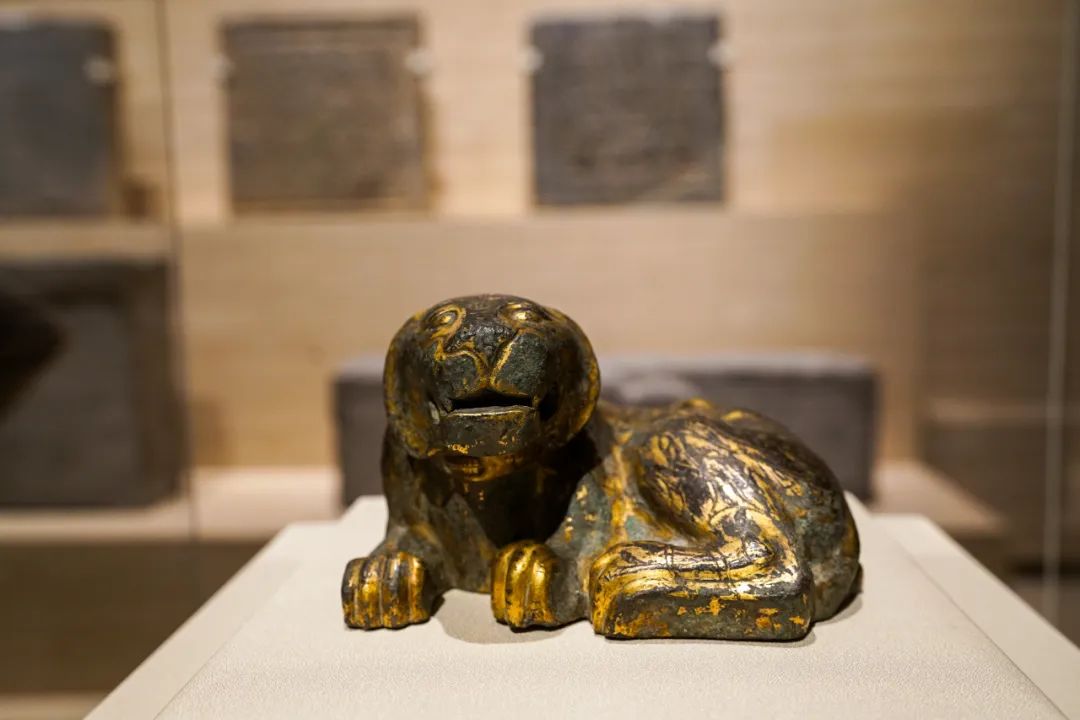
Tiger-shaped gilt copper town, Western Han Dynasty (206 BC-8 AD)
This piece of Huzhen has exquisite workmanship and vivid shape. It is a precious masterpiece of Han Dynasty craft sculpture. The tiger is curled up and lying down, with its head raised and its mouth raised. It wears a collar decorated with shell patterns on its neck. Its body is engraved with markings and its entire body is gilded. In the Qin and Han dynasties and earlier, people sat on the floor. In order to avoid affecting their appearance due to folding the corners of the mat and hanging their clothes when getting up and sitting down, mats were used to hold down the four corners of the mat. This Tiger Town is one of them.
Shitianren head fragments

Fragment of Shi Tianren's head, Northern Wei Dynasty (386-534 AD)
This celestial head comes from Cave 17 of the Yungang Grottoes. It has a round face and concentrated facial features, with obvious characteristics of the Western Regions. It is a statue of the first phase of Yungang. The Yungang Grottoes are a large-scale art masterpiece created by the Northern Wei Dynasty with the help of highly skilled artists and craftsmen. It fully embodies the style of the times. Its artistic style influenced the Buddhist grotto statues in various parts of northern China, and also affected the early sculpture art of the Southern Dynasties. It occupies a very important position in the history of Chinese sculpture. Sixteen Yungang Grottoes statues, including this head fragment of a deity, were collected from the Yungang Grottoes from 1939 to 1940. Seiichi Mizuno, Toshio Nagahiro and others from the Japan Institute of Oriental Culture formed a Yungang investigation team to clean up the "Tan Yao Five". It was collected during the "Caves" (Caves 16 to 20) and was transported back to Japan before the end of the Anti-Japanese War and was stored at the Institute of Oriental Culture in Kyoto. After the victory of the Anti-Japanese War, thanks to the efforts of Li Ji, Zhang Fengju and others, these statues were recovered and returned to China in 1948. After the founding of New China, in compliance with the instructions of the Central Government Affairs Council and the Shanghai Municipal People's Government, these cultural relics were collected in the Shanghai Museum in 1955. The return of these precious statues to the motherland reflects the Chinese people's protection of Chinese culture and their resistance to Japanese militaristic cultural aggression during the Anti-Japanese War. It is of great significance in the history of academic research on the Yungang Grottoes.
white stone buddha statue

White stone Buddha statue, Northern Qi Dynasty (550-577 AD)
The Buddha statue is carved from white marble. This white stone statue is made of high-quality materials and is exquisitely carved. Related research suggests that it may have originated from the Xiangtangshan Grottoes, a royal grotto of the Northern Qi Dynasty. It is a precious royal statue of the Northern Qi Dynasty. Buddha statues of similar size and style are known to be in the collections of the Victoria and Albert Museum in London, England, the Senucci Museum in Paris, France, and Japan. The white stone statues of the Northern Qi Dynasty mainly originate from Quyang, Dingzhou and Handan in Hebei Province. This is the area of influence of Dingzhou and the capital of the Northern Qi Dynasty, Yecheng. Dingzhou has a tradition of high-quality stone and carving, and Yecheng has many good craftsmen and pattern books. The body-hugging Buddhist attire and the pattern of the head bald are influenced by the Indian Gupta art. The Buddha statue has a larger head, slender upper body, and overall geometric shape, which are distinctive characteristics of the Northern Qi Dynasty. This style had a direct impact on Sui Dynasty statues.
Remaining stone statue
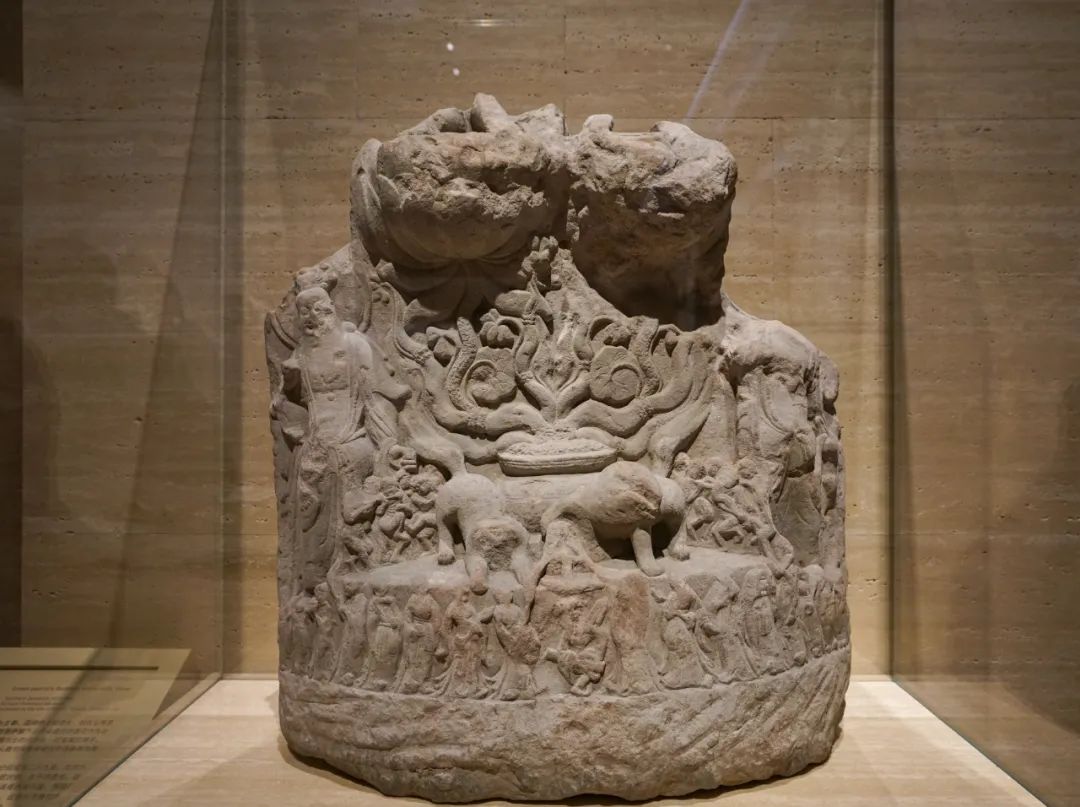
Remaining stone stele, Southern Dynasties (420-589 AD)
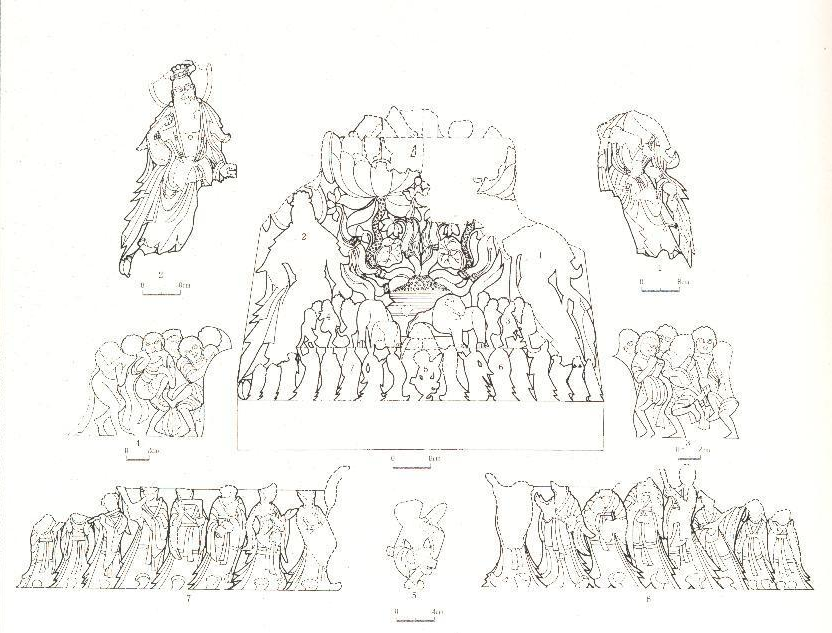
Remaining stone stele, line drawing of the Southern Dynasties (420-589 AD)
Collection of Sichuan Museum and unearthed from the Wanfo Temple site in Chengdu. Compared with the large number of statues from the Northern Dynasties, there are very few statues from the Southern Dynasties that have survived. Except for a few surviving statues in Nanjing and Jiangsu and Zhejiang regions, most of them were unearthed in the Chengdu area and Wenchuan, Maoxian and other places in the upper reaches of the Minjiang River. In order to complete the system of this exhibition and create the effect of confrontation between the North and the South in the Southern and Northern Dynasties, we specially borrowed two precious stone carvings from the Southern Dynasties unearthed from the Wanfo Temple site in Chengdu from the Sichuan Museum. This statue stele is one of them. The content and structure of the relief sculptures on the statue stele are consistent with the "Shangyun Le Kabuki" that Emperor Liang Wu participated in the creation. Emperor Wu of the Liang Dynasty and his ministers created "Shangyunle Kabuki" in the capital Jiankang (now Nanjing), using the songs, dances and customs of the Jingchu area in the Southern Dynasties that they were familiar with. Among them, the old Hu Wenkang came from the local Hutou, and was influenced by the people who lived here. Sogdian influence. The characters in "Shangyunle Kabuki" mostly wear masks to perform. It was originally performed at the Yuan Festival in the palace. During the Sui and Tang Dynasties, it developed into "Bunkang Libiqu" and was included in the "Nine Parts of Music" and "Seven Parts of Play" in the Sui and Tang Dynasties. Palace banquet performance. This group of musical reliefs proves that "Shangyunle Kabuki", as one of the early dramas in China, had been used as a Buddhist ritual performance in Xiaoliang, and was spread from the capital Jiankang to Chengdu and other regions along with Buddhist exchanges. central city. The name of Japan's "Kigaku", which is closely related to "Kamigumo Kabuki," is also related to the fact that it is mainly preserved in temples and performed in the palace as an offering. "Giraku" is one of the sources of Japanese drama, originating from China. "Jiyue" is also called "Wuyue", indicating that it originated from the mask song and dance dramas such as "Shangyunle Kabuki" that circulated in the Jiangnan region of the lower reaches of the Yangtze River from the late Northern and Southern Dynasties to the Sui Dynasty.
Three bronze statues of Amitabha, Sui Dynasty (581-618 AD)

Three bronze statues of Amitabha, Sui Dynasty (581-618 AD)
The Bodhisattva's crown on both sides of the Buddha statue is decorated with a transformed Buddha and a vase, which can be seen as the two Bodhisattvas Avalokitesvara and Mahasthamaprapta standing on the left and right of Amitabha. The statue is well-cast and graceful in shape. It is a representative work of Buddhist bronze sculpture in the Sui Dynasty. Similar gold and bronze statues include the bronze statue of Amitabha made by Fan in the 13th year of Emperor Kaihuang's reign (593) now in the Museum of Fine Arts, Boston, USA, and the gilt bronze statue of Amitabha made by Dong Qin in the fourth year of Emperor Kaihuang's reign (584) now in the Xi'an Museum. Bronze statue. There are obvious similarities between the Sanpu statues. For example, the main Buddha Amitabha has a low and bulging bun on his head, a square face, concentrated facial features, half-closed eyes, elongated upper body, wearing a cassock that exposes his right shoulder, and sits cross-legged on the waist and looking up at the lotus platform. above. These similarities can be traced back to the Northern Qi statues unearthed in Hebei, indicating that Sui Dynasty Buddhist statues were influenced by the Northern Qi style.
Gilt bronze statue of Meditation Bodhisattva
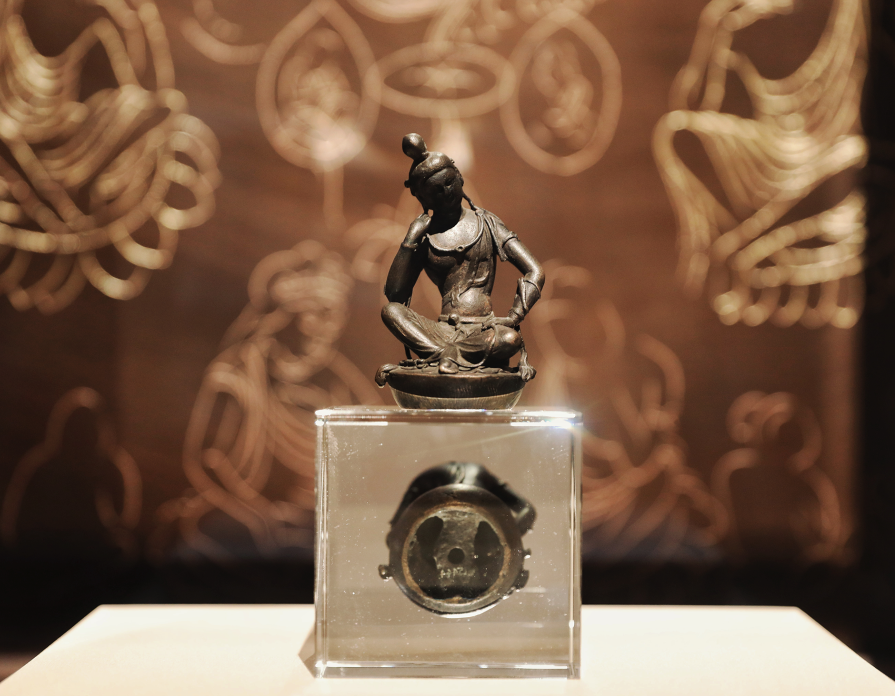
Gilt bronze statue of Thinking Bodhisattva, Tang Dynasty (618-907 AD)
This is a gilt statue of Bodhisattva. The Bodhisattva is sitting on a circular pedestal, with his left elbow bent to support his legs, and his right hand raised to support his chin, making a "thinking sign". He lowers his head and leans to the right, with his eyes down, as if he is immersed in meditation. , so he is called the "Thinking Bodhisattva". This gilt bronze statue of the Meditation Bodhisattva is 11 centimeters high, with exquisite casting and lifelike appearance. The Bodhisattva has high bun, hair tied around the shoulders, slender limbs, broad shoulders and waist, which embodies the statue characteristics of Chang'an during the Wu Zhou period. What is puzzling is that the bottom of the pedestal of this Bodhisattva statue is hollow, with a long bar in the middle, a round hole in the middle, and a depression on the inner wall of the base opposite the round hole. What is the meaning of these designs? Through the CT scan of this Bodhisattva statue, the internal structure of the pedestal has been revealed more clearly. It is speculated from this that this Bodhisattva statue may not be an independent single statue, but connected to a group of sculptures through accessories. Unfortunately, this gilt bronze statue of the Thinking Bodhisattva is the only one left, and we cannot know for certain the original appearance of the group of statues to which it belongs. Fortunately, in niche 19 of the Bishui Temple on the banks of the Fuling River in Mianyang, Sichuan, a gilt bronze statue of the Meditation Bodhisattva, which also belongs to the early Tang Dynasty, was found. Examples of group sculptures contemplating the Bodhisattva. This is a pavement of fifty statues of Amitabha Buddha. Below the whole group of sculptures, there is a carving of a lotus pond in the Western Pure Land. A trunk like a tree grows in the pond, and a large lotus flower blooms on it. Amitabha Buddha sits on this lotus flower. On both sides stand Guanyin Bodhisattva and Mahasthamaprapta Bodhisattva. Nearly fifty side branches grow on both sides of the main trunk. At the top of each side branch is a small Bodhisattva sitting in a lotus. Among them is a small statue of Bodhisattva similar to the gilt bronze statue of Thinking Bodhisattva in Shangbo. A comparison of the two shows that this gilt bronze statue of the Thinking Bodhisattva is probably a small sided Bodhisattva next to the main Buddha statue. The circular pedestal below it is a lotus, connected to the entire group of sculptures through a copper lotus stem. Due to the lack of physical evidence, the original appearance of the group of sculptures to which this Bodhisattva statue belongs remains an unsolved mystery, leaving it to our imagination. During the early Tang Dynasty, ancient Indian Gupta-style thought was introduced to China along the Silk Road, and soon influenced Japan from China. Thinking about the Dharma spans thousands of years, leaving behind a trace of reflection in the prosperous times, which makes people nostalgic.
Stone Buddha Head
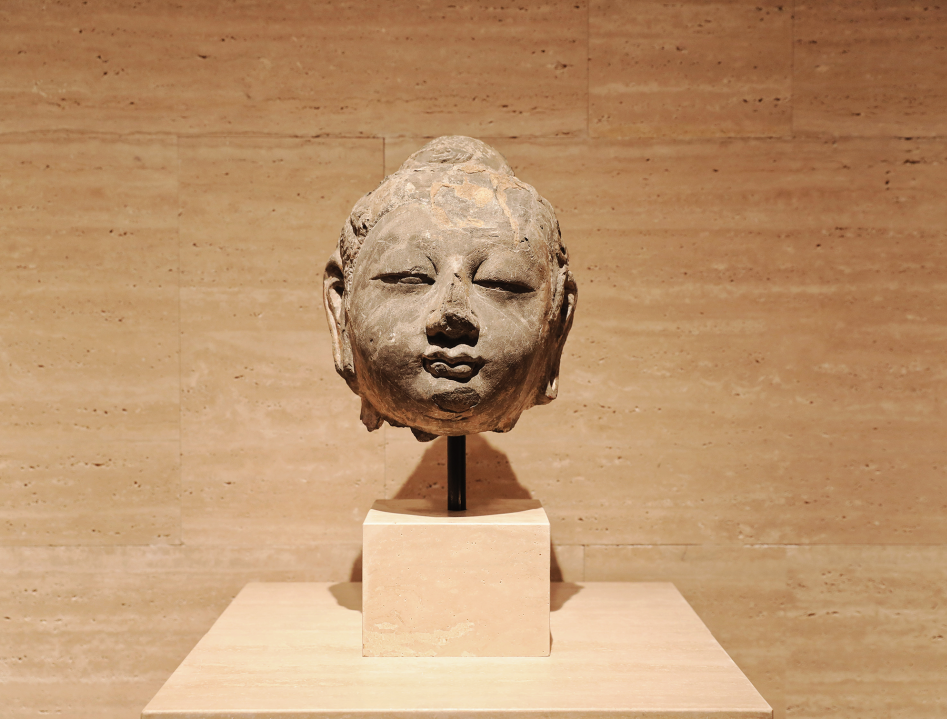
Stone Buddha Head, Tang Dynasty (618-907 AD)
Twenty-one Buddhist niches of similar size are carved between the nine open-air statues of Fengxian Temple in Longmen Grottoes. Each niche is carved with one to five life-size standing Buddhas, and there are forty-nine of them now. This Buddha head originates from the middle one of the three life-size standing Buddhas in the large arched niche on the lower floor outside the stronghold on the north wall of Fengxian Temple. These standing Buddhas are nearly 1.9 meters tall, with plump faces, stalwart torsos and slightly fat figures, showing the characteristics of statues from the Kaiyuan period of the prosperous Tang Dynasty. Relevant studies believe that these life-size standing Buddhas may have been created based on the wishes of Emperor Xuanzong of the Tang Dynasty or his close associates to perform meritorious deeds for Xuanzong. The fat Buddha statue style originated from Chang'an and is a precious material for studying the relationship between Longmen Grottoes and the Tang royal family.
White stone offering to Buddha statue

White stone statue of Bodhisattva, Tang Dynasty (618-907 AD)
This statue of the Bodhisattva has her hair in a high bun, a crown, and ribbons hanging from her shoulders. The face is round, the eyebrows are curved, the eyes are half-open and looking downward, the bridge of the nose is straight, and the lips are slightly pursed with a smile, making him look quiet and peaceful. A necklace composed of beads is worn on the neck. A shawl droops from the shoulders, and hangs around the left and right arms on both sides of the body. The upper body wears a monk's branch, and a belt is fixed between the chest and abdomen. The lower body wears a long skirt, and the skirt belt hangs down from the middle. The Bodhisattva is missing both forearms and hands, and is kneeling on the lotus platform with his bare feet.
The white stone Bodhisattva statue in Shangbo is probably part of a group of sculptures consisting of the main Buddha statue and his attendants, that is, the supporting Bodhisattvas located below the Buddha. This Bodhisattva statue is made of white marble. In ancient white marble (referred to as white stone) statues and vows, this type of stone statue is often called "jade statue". Especially during the reign of Emperor Xuanzong of the Tang Dynasty, white stone statues in Chang'an reached their peak. This white stone offering Bodhisattva statue originated from Chang'an during the Xuanzong period. In terms of material and craftsmanship, it is closely related to the white stone statues in the area east of the Taihang Mountains. It is an excellent work of white stone statues in the prosperous Tang Dynasty.
The white stone statues of the Xuanzong period used the delicate material of marble to vividly demonstrate the soft and elastic texture of the skin, and the depictions were realistic and meticulous, as if the cold stone also had body temperature. After the carving of the white stone statue is completed, the statue must be gilded and colored, which is called Zhuluan. The white stone statues unearthed at the Anguo Temple site in Xi'an retain splendid gilding and paintings. There are still traces of painting on the chest, abdomen and long skirt of the Bodhisattva statue in Shangbo. You can imagine how gorgeous this Bodhisattva statue was back then.
Lacquered gold painted wood carving statue of Mahasthamaprapta Bodhisattva

Lacquered and painted wood carving of Mahasthamaprapta Bodhisattva, gold (1115-1234 AD)
This wooden seated statue of Mahasthamaprapta comes from the Fen River Basin in southern Shanxi. During the Jin and Yuan Dynasties, wood carvings flourished in this area, showing characteristics such as strong stature, gorgeous decoration, three-dimensional carvings, smooth lines, and exaggeration. The torso of this type of wood carving is mostly carved from a whole piece of wood. The torso is hollowed out for storage, and the head, limbs, decorations, etc. are carved separately and then assembled with mortise and tenon joints, wooden dowels and iron nails. The style of gold and Yuan wood carvings in the Fenhe River Basin in southern Shanxi is consistent with the style of local temple murals in the Yuan and Ming dynasties, reflecting the characteristics of ancient Chinese sculpture art that both painting and sculpture were emphasized.
Gilt bronze Buddha statue with the sun shining all over it
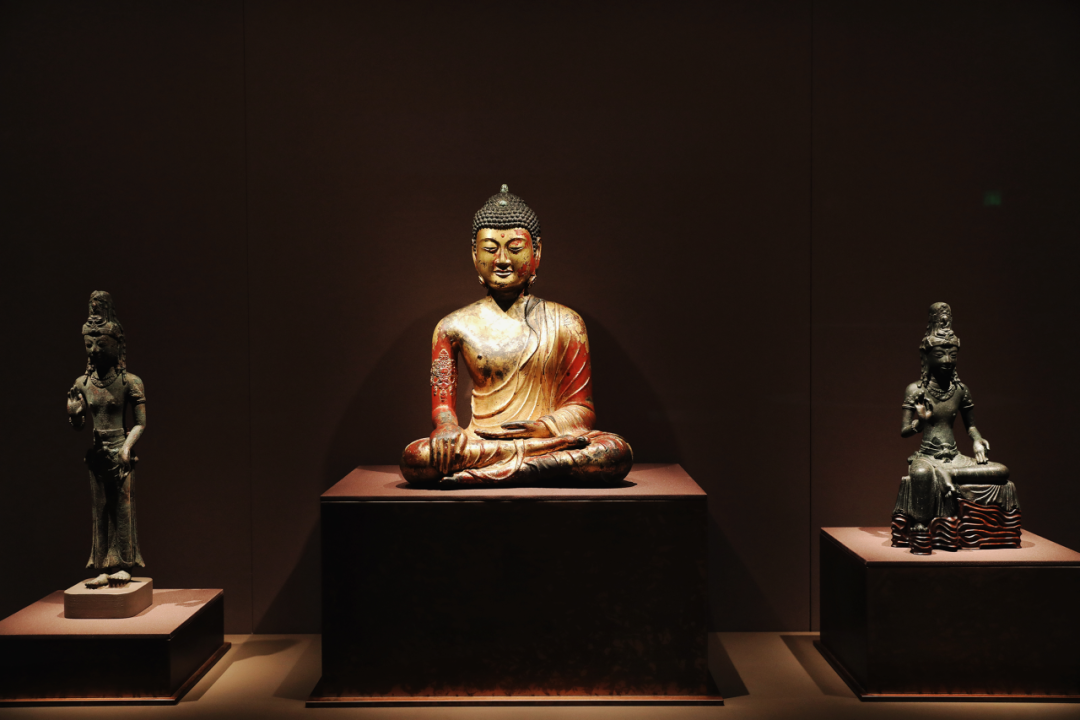
Gilt-bronze Buddha statue with the sun shining all over it, the second year of the Ming Dynasty of Dali (AD 1163)
This Dali Sun-illuminated Buddha statue is the largest of its kind among the gold and bronze Buddha statues, and is extremely precious. The inner cavity of the Buddha statue contains the inscription that in the second year of the Ming Dynasty of Dali Kingdom (1163 AD), Zhang Xingming and others vowed to build a gold and bronze statue, and the sun would shine all over the body. Zhang Xingming's official title is Yanbi, which is similar to a prime minister and has a distinguished status. This statue is consistent with the image of the Buddha in the south without the sun shining all over it in the 84th chapter of "Zhang Shengwen's Painting of Dali Brahma Statues". The treasure-clad Buddha statues decorated with earrings, armbands, and the seal of subduing demons and touching the ground originated from Bodhgaya, India, and were introduced to Chang'an in the early Tang Dynasty. The inscriptions on Buddhist statues of this type in the Guangyuan Grottoes of Sichuan in the Early Tang Dynasty are recorded as the Bodhi Statue. The shape of the Great Sun Shining Buddha in Dali was influenced by the treasure-clad Buddha statues of the Tang Dynasty in Sichuan. This Buddha statue was lost to the United States in the 1940s and then to France. In October 1998, Mr. Ma Chengyuan, director of the Shanghai Museum, purchased it back during his visit to France. Mr. Kong Xiangmian, chairman of the First Bank of Zhejiang in Hong Kong, generously donated funds to collect the funds and donated them to the Shanghai Museum in the name of his father, Mr. Kong Shouheng. On February 2, 1999, the Shanghai Museum held a grand cultural relics donation ceremony for this Dali National Sun-illuminated Buddha statue.
Dadu Buddha Zhang built a Qingtian stone Buddha statue
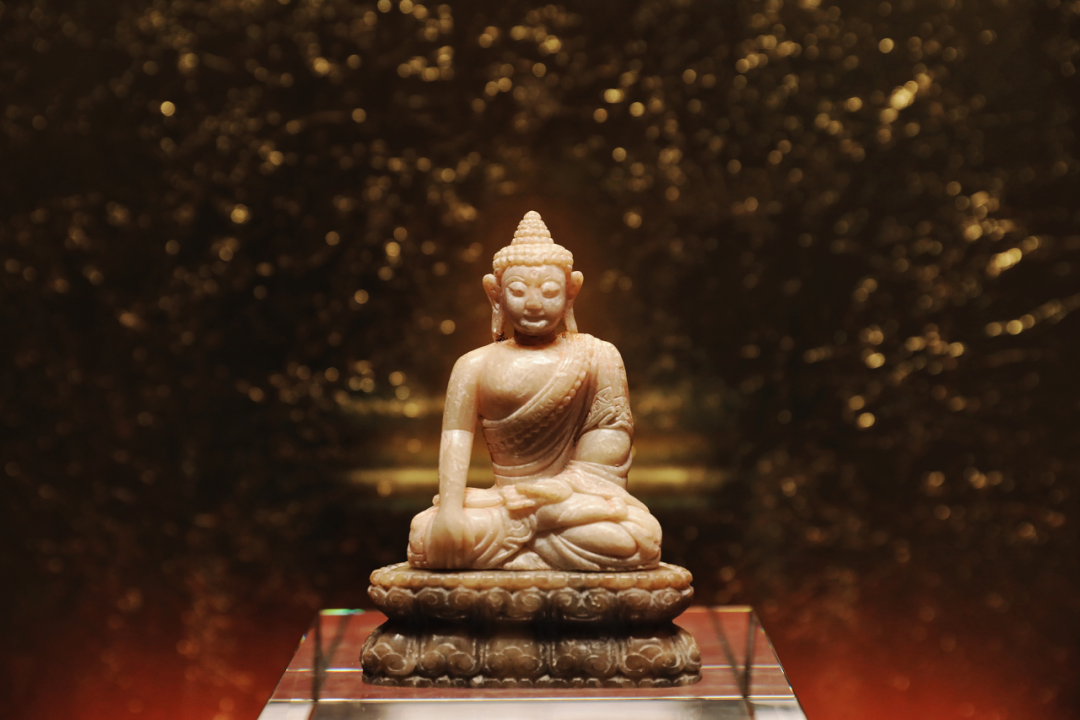
Dadu Buddha Zhang built a stone Buddha statue in Qingtian, Yuan Dynasty (1271-1368 AD)
The Buddha statue has a tall bun, broad shoulders, and a straight chest. It is a standard Tibetan-Han style statue in Dadu (Beijing) area in the mid-14th century. It is the only standard Yuan Dadu statue unearthed by archeology with Dadu inscriptions. It is extremely precious. The base is engraved with the inscription "Dadu Buddha Zhang Zao", and the last character is a combined seed character, which represents the logo and legal principles of this Buddha statue. "Fo'er Zhang" should be the modest name of the statue maker named Zhang, which expresses the piety of the statue maker. In most of the cities, the Nepali architect and artist Anigo, who was in charge of the Buddhist statue lifting department, and his disciple Liu Yuan created a unique statue style that combined Nepal, Tibet and Han, and became the regulation of royal statues in the Yuan Dynasty. Known as the "Western Brahma Statue". This Buddha statue was unearthed in the Yuanying Pagoda Underground Palace in Songjiang District, Shanghai in 1994. It reflects the influence of Tibetan Buddhist art in the Yuan Dynasty on the Jiangnan region.
